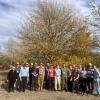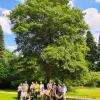Editor's Picks
Plant Focus
In Portugal, in the district of Santarém, on approximately 2 kilometers of Estrada Nacional (National Road) 114 near Rio Maior-Caldas da Rainha (Senhora da Luz), around 190 trees are marked, possibly for felling by order of Infraestruturas de Portugal, the Portuguese public company responsible for maintaining Portuguese roads. The majority are Portuguese oak (Quercus faginea) and cork oak (Q. suber), some of which are monumental, forming an arboreal tunnel with high ecological and landscape value.

During last summer, some people protested to Infraestruturas de Portugal (IP) and other entities against the felling of oaks (Q. faginea), ash trees (Fraxinus angustifolia), poplars (Populus sp.), cork oaks (Q. suber), and cypresses (Cupressus lusitanica) on the same road, between Rio Maior and Santarém. The media recorded the facts, as well as IP's arguments for the indiscriminate felling of trees, including:
1) the action aims to improve road and pedestrian circulation;
2) tree pruning and felling activities on EN114 were preceded by the respective technical expert opinion to assess intervention needs;
3) fifty-five percent of the trees targeted for intervention are invasive species, namely Acacias and Ailanthus: the felling and control of these species is currently of the utmost importance, as they constitute a serious and growing problem, particularly due to the obstruction of equipment signs,the invasion of verges, drainage systems, and agricultural land bordering the road, and because they are factors in the loss of biodiversity;
4) not all of the situations highlighted are noticeable to those traveling on the road, which is why it is often necessary to cut down apparently healthy trees;
5) materials resulting from pruning or felling are sent to an appropriate final destination in accordance with legislation;
6) as a compensatory measure, trees are planned to be planted in several municipalities in the district of Santarém.
IP's responses present many gaps in technical information, meaning public opinion must be clarified regarding tree management options. Therefore, there are issues that are not clear in IP's argument:
1) How does this action aim to improve road circulation? Are there situations in which the canopies or trunks of trees disturb or make it difficult for cars to circulate?
2) Who prepared the technical opinions? Were they technicians with proven knowledge, competence, and experience in tree assessment? Was it an assessment based solely on visual observation, or was it supported by phytopathology and biomechanical analysis and diagnosis?
3) The presence of invasive species such as Acacias and Ailanthus in Portugal is, in fact, a valid argument, due to their ability to spread, which can cause serious problems on roadsides and drainage systems. In reality, on the section of EN114 between Rio Maior and Santarém, over a 15-kilometer stretch, around 470 trees were cut down, the majority of which were Portuguese oaks, cork oaks, cypresses, poplars, and ash trees. These species mentioned are native to the Portuguese flora with the exception of cypresses and none of these species have invasive behavior.
4) It is necessary to specify and clarify the situations that are “not noticeable” from the road. How were these situations diagnosed? Are they based on risk assessments? Were phytopathology analyzes carried out? Have wood diseases been diagnosed? Have any biomechanical analyses been carried out to assess the structural stability of trunks and branches?
5) What was the destination of the wood and branches resulting from the tree fellings carried out?
6) There are no measures that can compensate the cutting of trees already carried out in EN114, as well as the continuation of felling of large oaks and cork oaks. These are secular trees. In 1929, Forestry Engineer Joaquim Vieira Natividade (the most renowned Portuguese forestry researcher of the 20th century), stated that: "And secular oaks, like the great architectural jewels that the pious hands of artists lovingly erected, belong to the past. If they disappear they are not replaced, incompatible as they are with the dizzying progress of the present time." The felling of the large oaks in Senhora da Luz highlights the inability to replace them and constitutes an irreparable loss!
In the case of implementing compensatory measures in the district of Santarém: where are they planned, how many trees will be planted, which species, and when?

There are doubts about the technical justifications for the felling of trees in EN114! It is pertinent and urgent for IP to be clearer and ecologically responsible in its tree management options and in their public disclosure. In the case of the Senhora da Luz section of the road, the existing trees, made up mainly of Q. faginea, are trees of undeniable ecological, aesthetic, and landscape value.
It is important to add that there are some oak trees on site with monumental attributes, for example, a Q. faginea with a circumference at breast height of 3.30 m and a circumference at base of 3.70 m. This oak deserves to be classified as being of public interest, based on size criteria, in accordance with the classification criteria for trees of public interest established in Ordinance No. 124/2014. D.R. No. 119, Series I, June 24 and framed by Law No. 53/2012. D.R. No. 172, Series I, of September 5, which approves the legal regime for classifying trees of public interest.
It is important to mention some notes regarding the Q. faginea. Portugal is one of the few countries in the world where the species exists naturally (together with Spain, Morocco, Algeria and Tunisia). Therefore, we must assume our responsibility, as a state and society, in conserving this species. We must now guarantee the preservation and conservation of Q. faginea forests of high ecological value, as well as the most notable isolated oaks of this species.
With some exceptions (as in the case of trees classified as being of public interest), Portuguese large oaks do not have legal protection. However, with the awareness of society, political leaders, owners, and entities managing land where these oaks exist, there is hope of conserving the majority of these secular, unique, and irreplaceable oaks. Their age spans several generations, being a legacy from the past that must be passed on to future generations.
And based on these concerns, a group of citizens is trying to alert public opinion and political decision makers to evaluate whether there is an effective need to fell all the trees in this group on the side of Estrada Nacional 114 of Senhora Luz in Rio Maior.

More photos of the oaks can be viewed here.















